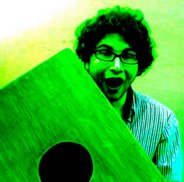
The bus ride from Lima to Arequipa, Peru's second largest city, took 14 hours. I sat on the second level of the double decker bus, in the front row. The way the windshield continued to the top of the bus and connected to the side window created a completely open view that was both terrifying and amazing, the sun rose over jagged rock, specked with gigantic cacti sloping into the pacific ocean, we drove along narrow winding highway, teetering over the edge of sand covered cliffs, crossing the yellow line to pass a truck and ducking back just in time to miss an oncoming bus on its way to Chincha, the door separating the bus driver from the passengers is opened and you can see the people standing in the isle, into the desolate desert , to the "White City" at the foothills of El Misti Volcano. The man sitting next to me worked for a gold company. He used to work in the mines near Arequipa. He told me how the gold was processed from rock to dust to solid brick. He told me that he played guitar and how the sound of the guitar would carry down in the mine. It was his favorite place to play. We watched a promotional video. A short video about Peru, its people, places, and culture, and its Pride. When it was done my new friend turned to me and said, "Somos Orgullosos." We are proud.
Living in Peru you don't need a video to tell you how proud Peruvians are, but an experience like this puts Peruvian pride into perspective, and its only too fitting that this happened on the way to Arequipa a city and region that views itself as its own sovereign nation and has tried in the past to secede. Here pride is rooted in the past, in the time before Spanish colonization. There is no better example of this than music. When the Spanish conquered the Incas and colonized Peru they banned all music and tried to destroy all native instruments, forcing indigenous peoples to give up all aspects of their culture. Today much of the music in Peru is an ode to times past, and this ode is not in the lyrics, it is in the instruments themselves. It is in the flutes and pan pipes that the Incas played years ago along the Inca trail and are the basis for Andean pop today. Not only are they a reminder of the past but they are also an up yours to their Spanish conquerers. Even in the coastal, afro-Peruvian music, which has a much heavier guitar influence than the music of the Andes the use of the cajon, an instrument native to Peru, is a stand against occupation.
Zapateo is based on Spanish dance styles but it is the Peruvian influences that makes it so unique. Here is the last part of the Zapateo-off. This part is free style.




